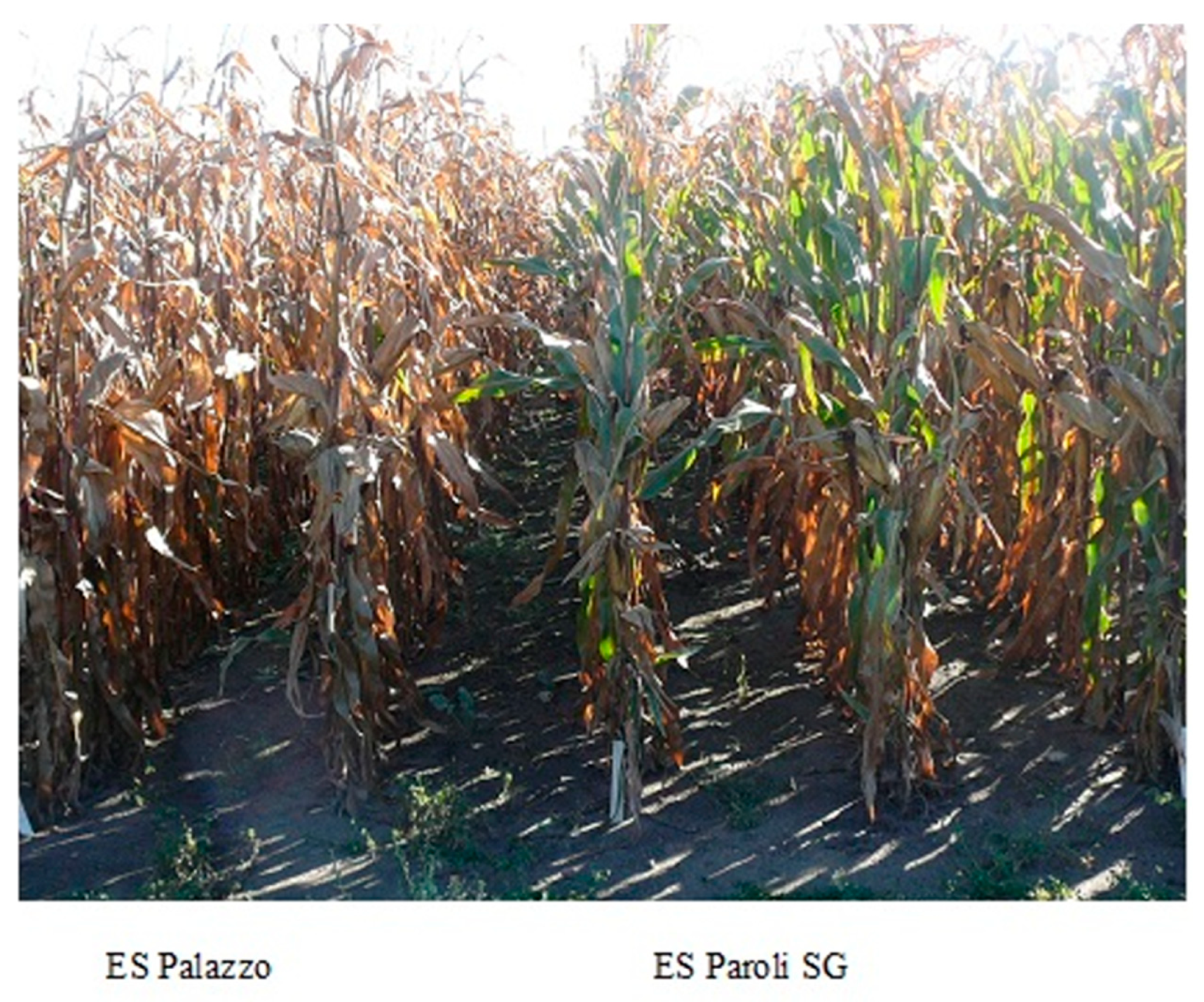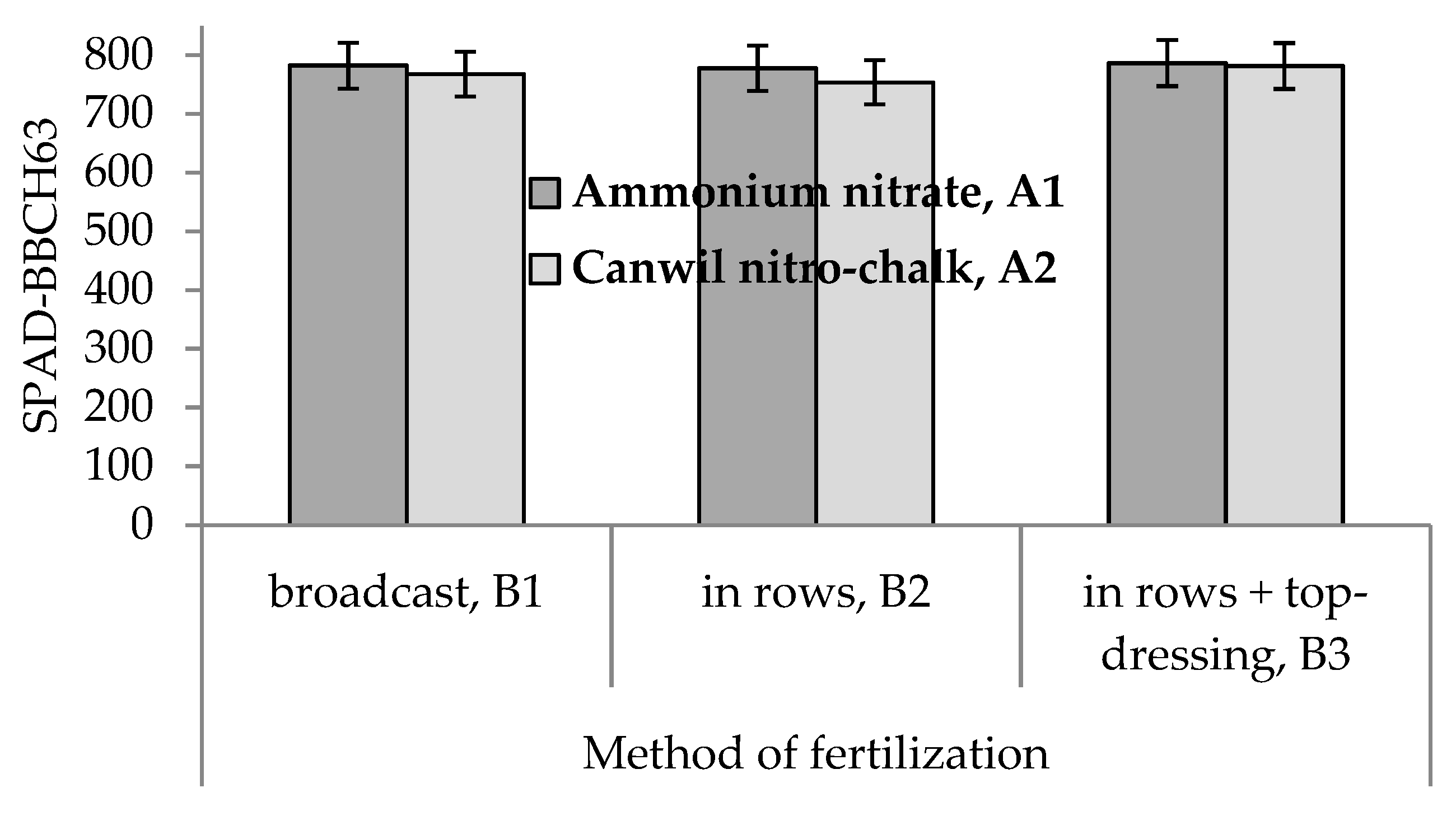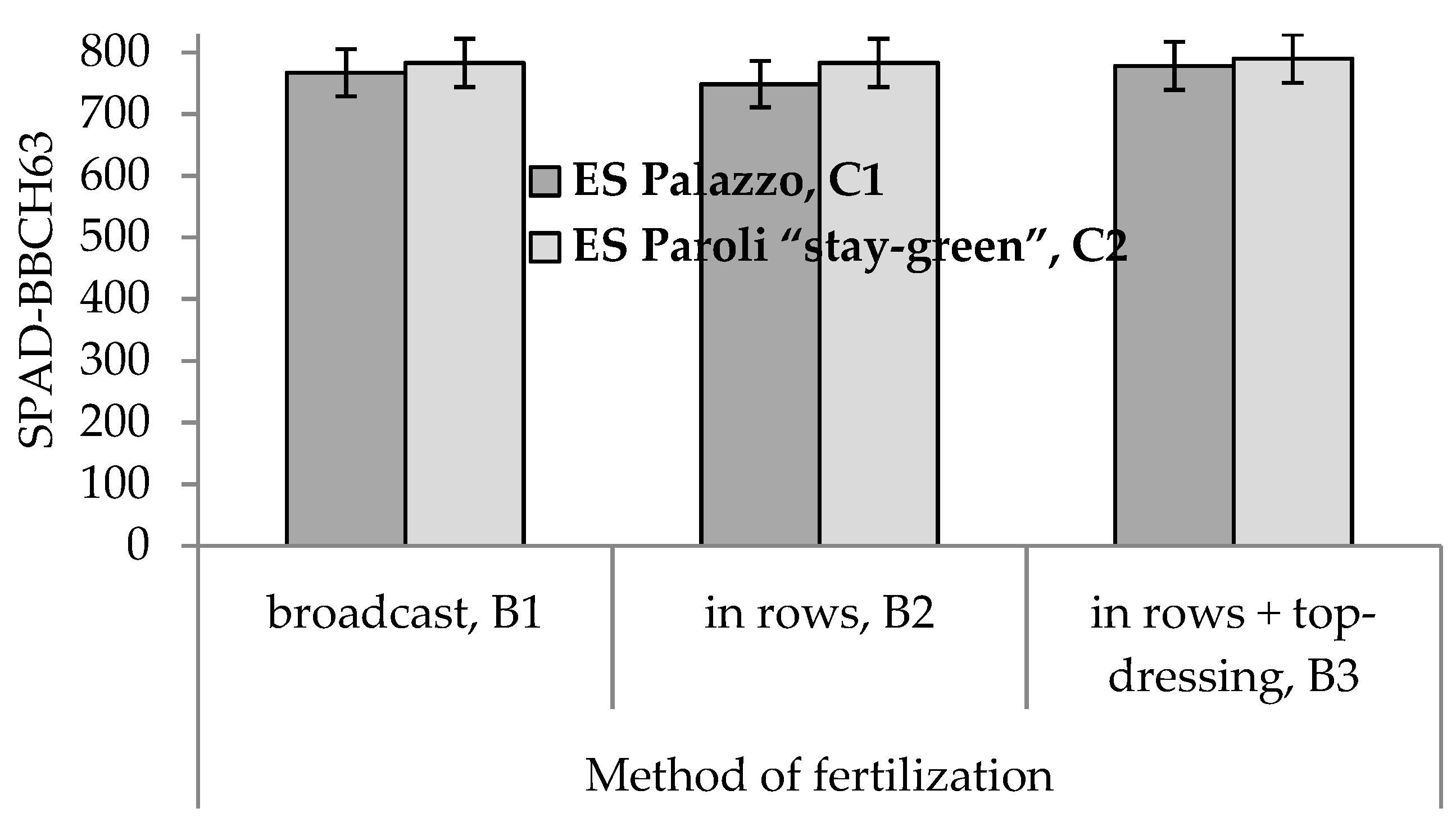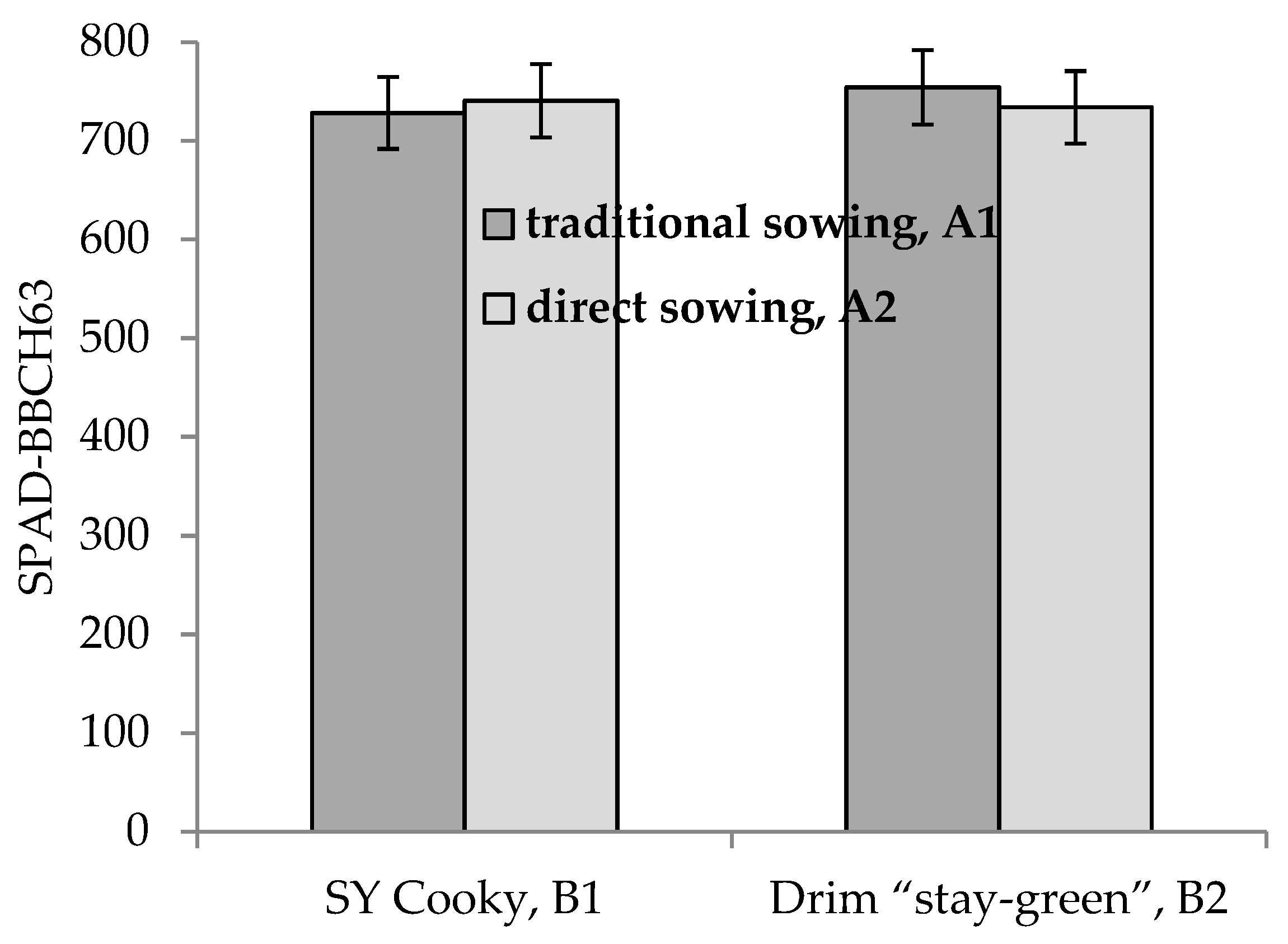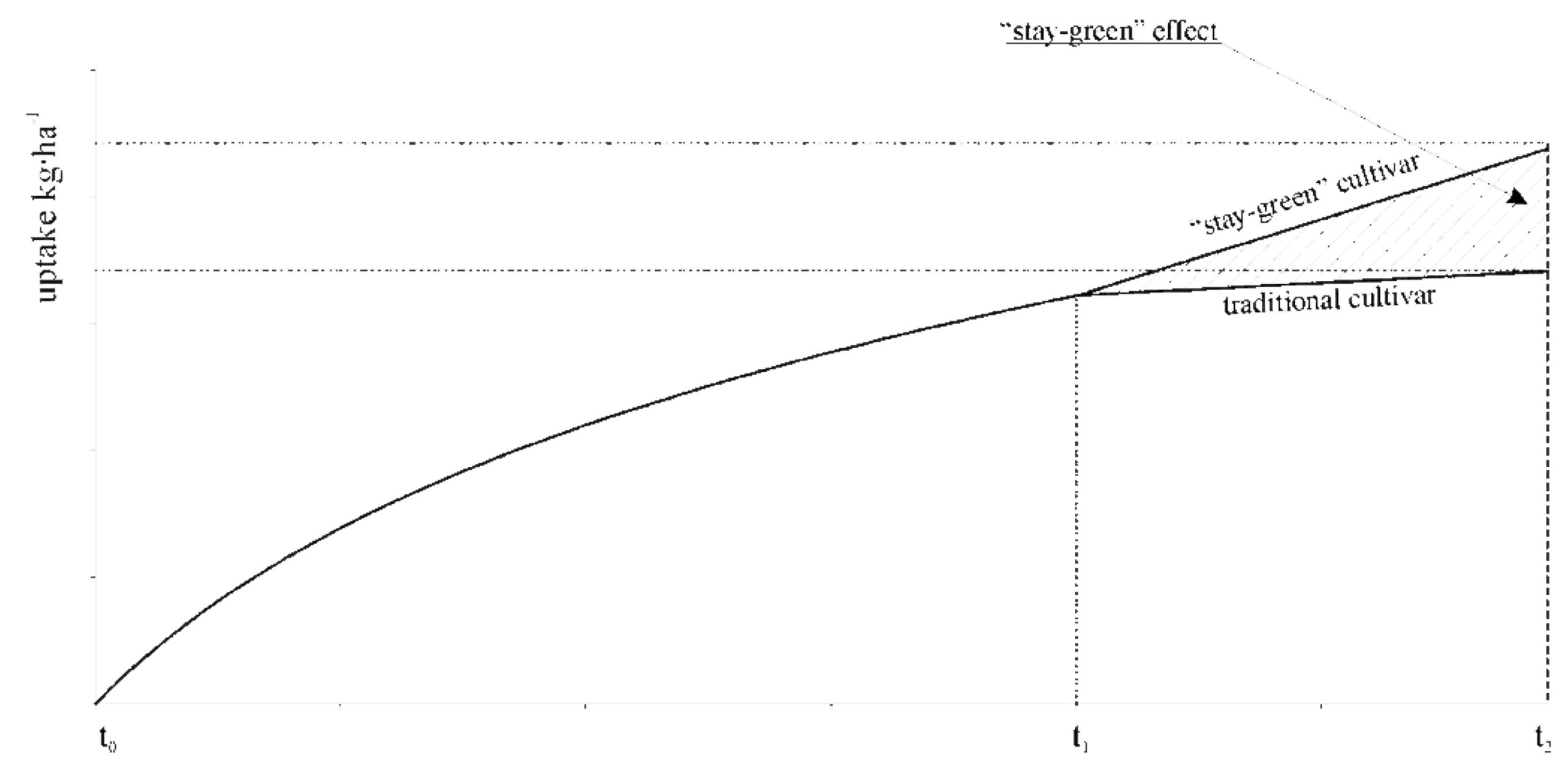1. Introduction
Balanced fertilization is the basic task of sustainable agriculture [
1], which should take into account all the nutrients necessary for proper growth and development [
2,
3]. Ensuring the optimal level of plant growth factors, including nutrient availability, guarantees the accomplishment of the yield potential [
4,
5]. Maize (
Zea mays L.) is characterized by a high ability to absorb nutrients that are used in mineral fertilization [
2]. Therefore, doses of mineral fertilizers should correspond to the nutritional needs, taking into account the amount of components that can be taken up from the soil [
6]. Some of the reasons for low maize yield are acidic soils, insufficient nutrient supply, as well as failure to adjust the fertilization system to quantitative needs, especially the dynamics of nutrient uptake by plants throughout the growing season [
3]. Periodic water deficiencies in the soil (drought), frequent in growing seasons, limit the yield potential of new, often more fertile maize hybrids [
7,
8]. Due to unpredictable weather conditions, the creation of hybrids with advantages in an environment with limited water resources is one of the main challenges faced by breeders [
9]. “Stay-green” maize hybrids belong to such varieties. This is the result of a better developed root system [
10] and a faster initial growth dynamic [
11]. Hence, breeding works should be focused on greater plant health in the later growing season [
12] and/or on increasing leaf greenness, known as “stay-green” [
13]. This trait is an indicator of good plant health, slower aging rate (
Figure 1), and drought tolerance after flowering [
14]. The “stay-green” trait shows a positive correlation with plant yielding [
15,
16]. However, the cause-and-effect relationship between these traits and grain yield is limited by the duration of the growing season and genetic basis of the cultivar under study [
17,
18].
Plant yielding potential is usually assessed by comparison of cultivars grown with employment of up-to-date agronomic methods which eliminate biotic stresses (diseases, pests, weed infestation). In real terms, the correlation between genetic and agronomic progress is an important factor in influencing plant yielding potential, and cannot be attributed to neither breeding (cultivar) nor agronomy. Hence experimental researches—field experiments, aimed at assessment of cultivars depending on their type, are so important. Only such a procedure can be a determinant of progress in plant production.
The SPAD BBCH17/18 (7–8 leaf stage), SPAD BBCH63 (the beginning of pollen) and yield are the quantitative traits which are determined by large number of genes. Expression of these traits is a result of effects of environmental and quantitative trait loci (QTLs). Genetic distance between the studied hybrids influences the values of the observed traits. Simple sequence repeats (SSR) or microsatellite markers can be useful tools in taxonomy and are traditionally used for the analysis of genetic similarity/distance among genotypes.
Therefore, the aim of the conducted field study is to determine the influence of various agriculture factors on: (i) shaping green mass of maize, (ii) the SPAD index in critical stages of maize growth, (iii) determination of the relationship between the SPAD leaf greenness index and the yield of maize green mass intended for ensilage, (iv) genetic similarity between cultivars on the basis of microsatellite markers. The adopted assumptions were verified on the basis of two field experiments carried out over a period of six years.
3. Discussion
In recent years, enormous progress has been made in maize agriculture practices, and it consists of genetic progress, development of cultivation technologies, and improvement of quality parameters [
19,
20]. High maize for grain productions performance and versatile application possibilities result in a systematic increase in maize cultivation area in the world, which is unmatched by any other leading crop [
21]. Currently, in terms of the sown area, it is second only to winter wheat (
Tricitum aestivum L.), but it decisively dominates in terms of the quantity of harvested grain, which is also the main agricultural commodity in the world trade [
21]. Allocating the field area for maize increases the efficiency of crop rotation, while a higher proportion of maize silage in the ration improves the profitability of animal feeding. Due to the deterioration of milk production profitability, it is necessary to further increase the maize cultivation for silage [
22] and measures aimed at improving the quality of the produced feed [
23]. Therefore, field research on the improvement of maize agrotechnics is a response to the above statement.
During the growing season, maize needs about 250 mm of rainfall in central Europe conditions. The critical period for water supply in maize is 40 days, of which 25 days fall before and 15 days after flowering. It usually occurs between 25 June and 15 August (depending on the variety). During this period, rainfall should provide 100–150 mm of water, depending on the prevailing temperatures. According to Zhao et al. [
24], an increase in the average global air temperature by 1 degree Celsius reduced maize yield by 7.4%. The results obtained in the current study indicated the importance of weather conditions, mainly hydrothermal, which varied between the years of research, on the obtained green mass of maize and other crops [
25,
26]. The average lowest yield of maize green mass for the years was recorded in 2011 (49.17 t ha
−1—Experiment I) and 2014 (54.28 t ha
−1—Experiment II). These were the years characterized by the lowest total precipitation, with the highest average daily air temperature (
Table 9).
Substrate moisture is one of the features that determines the nutrient supply to the developing plant root system. As reported by Qin et al. [
27] and Nkebiwe et al. [
28], diffusion process as a result of which the nutrient is delivered toward the root occurs faster in a moist environment than in a dry one. The results obtained in the present study clearly showed that the localized fertilization could be a method reducing the effects of periodic water shortages during the maize growing season. According to Singh et al. [
29], fertilizers placed in soil with a high moisture content were more accessible to plants than those placed on the surface, which was also shown in this study. Improved efficiency of fertilizer application into the soil, compared to traditional fertilization applied on soil surface, is conditioned by the high concentration of the component in the immediate vicinity of the roots, stimulation of root system growth, and reduction of nutrient loss to the environment [
30,
31]. The presented results have clearly shown that row fertilization is an agriculture solution that allows for a significant increase in the size of maize biomass intended for ensilage.
Regardless of the weather conditions over the years, significantly higher green mass yield was obtained for maize sown in the cultivated soil compared to direct sowing into stubble. The difference between sowing methods was 14.11 t ha
−1. The results of other studies [
32] also indicated that the tillage method had a strong influence on maize yield. The prevailing opinion in the literature is that the use of simplified cultivation, and in particular direct sowing [
33], causes a significant reduction in grain yield, maize straw yield, and protein yield [
34]. It was found in this study that the “stay-green” cultivar was characterized by significantly higher maize green mass yield compared to the classic cultivar. The difference between the tested cultivars was 2.91 t ha
−1 in Experiment I, and 4.09 t ha
−1 in Experiment II (4.09 t ha
−1). Szulc [
35] demonstrated that in the maize vegetation period, the “stay-green” type hybrid exhibited a greater increase in dry matter of a single plant than the traditional cultivar. Also the values of absolute growth rate (AGR) of dry matter of a single plant, dry matter of leaf blades, and dry matter of grain were higher for the “stay-green” type cultivar when compared to the traditional cultivar. The differences in an increase in dry matter of a single plant grew together with cultivar generative development. The result confirms earlier reports [
36]. According to this author, the second critical period of maize demand for nitrogen can be observed in the beginning of flowering. During the period from the tasseling stage (BBCH 55–59) to the stage of full silking (BBCH 65), the rate of nitrogen accumulation by maize is doubled (
Figure 5). However, increased maize demand for nitrogen is short and decreases in the milk stage to the initial level, i.e., the rate of nitrogen accumulation before full flowering. According to this author, nitrogen uptake is in accordance with the course of dry matter accumulation by maize. A decrease in the rate is more gentle, and ends at the early dough stage, i.e., at dry matter content of 45%.
The result obtained in the current study was consistent with the previous report of Szulc et al. [
38]. Higher grain yields obtained under row fertilization were also achieved by Mascagni and Boquet [
39]. Higher yield as a result of row fertilization resulted from improved plant nutrition with nitrogen (N-NI) and phosphorus (P-NI) in the juvenile phase [
40]. This was confirmed by Leach and Hameleers [
41], who found that high phosphorus concentration in the dry mass of maize plants before the 6-leaf stage significantly increased maize yield. Subedi and Ma [
42] also found that proper plant nutrition in the juvenile stages had a decisive effect on the final maize yield.
In agricultural practice, a fast and non-destructive method of assessing the nitrogen nutritional status of plants is commonly applied [
43,
44]. It consists in determining the intensity of leaf greenness using a SPAD-502 optical device (Soil and Plant Analysis Development) or an N-Tester (Hydro) [
45]. Both of these devices do not directly measure the chlorophyll content of plant leaves, but only determine the greenness index, which is the quotient of light absorption at two wavelengths, 650 and 940 nm. Rostami et al. [
46] reported in a study on maize that the yield of this species was significantly linearly correlated with the SPAD index values. This linear relationship indicates that the SPAD index can serve as a tool to estimate the yield of maize biomass for silage as well as grain yields. Chlorophyll content in plant leaves is considered a predictor of yield size. It accounts for over 98% of the variation in gross primary maize production [
47]. By measuring chlorophyll content, one can indirectly assess the potential absorption of infrared radiation and leaf ability to remain green [
48]. The ratio of radiation absorbance at 650 nm and 940 nm can be calculated using soil plant analysis development (SPAD). The SPAD reading indicates a positive relationship with maize yield as a result of energy transport from photosynthesis due to increased production, or indicates a negative relationship with efficiency if energy is re-metabolized from chlorophyll. A study conducted by Ghimire et al. [
49] clearly showed that the content of chlorophyll expressed in SPAD units was positively correlated with grain yield. Our research also demonstrated that determining the values of correlation coefficients between plant traits helps to estimate the degree of dependence, which can then be used to predict the response of fresh matter yield to the SPAD index in different phases of plant growth (statistical significant correlation coefficients between all pairs of traits for all three years of study in both experiments, except
r = 0.07 between SPAD-BBCH15/16 and SPAD-BBCH63).
Generally, genetic divergence is not the same as phenotypic divergence but in our results we obtained association between genetic similarity of four cultivars and three observed traits: SPAD-BBCH15/16, SPAD-BBCH63, and yield. More genetic similarity was observed for cultivars from the same seed company, and less when we are comparing across companies.
5. Conclusions
Thermal and humidity conditions in maize growing seasons determine the value of the leaf greenness index (SPAD) and the yield of maize harvested for silage.
The row application of mineral fertilizer (N, NP) in maize cultivation is more effective compared to broadcast fertilization, which clearly results in obtaining a higher yield of green maize mass.
The condition for using the biological progress represented by the “stay-green” maize variety is the simultaneous recognition of yield physiology aspects and development of plant nutrition on this basis. Selection of “stay-green” varieties for silage cultivation guarantees high biomass yields for ensilage.
The row application of mineral fertilizer was better suited to the “stay-green” maize cultivars, the clear effect of which was the difference between the studied varieties in chlorophyll content expressed in SPAD units in the BBCH 63 stage (start of pollination).
The division of nitrogen fertilizer dose (ammonium nitrate, Canwil calcium ammonium nitrate) into pre-sowing row fertilization and top dressing applied at the BBCH 15/16 stage (5–6 leaf stage) increased chlorophyll content in SPAD units in the BBCH 63 stage (start of pollination) compared to the broadcast and row fertilization.
The negative effect of direct sowing on the yield of maize green mass was most likely caused by the reduced plant root system, which could be largely compensated by variety selection, and especially by row application of NP fertilizers.
The SPAD leaf greenness index (Soil and Plant Analysis Development) determined in critical stages of maize growth can be considered as a yield predictor of green mass for ensiling.
The examined maize cultivars were divided into two groups as a result of hierarchical grouping using the unweighted pair group method of arithmetic means. One of the groups comprised cultivars SY Cooky and Drim “stay-green,” while the second one: ES Paroli “stay-green” and ES Palazzo.
